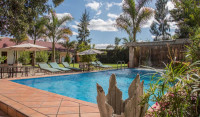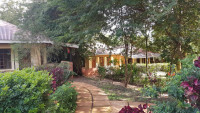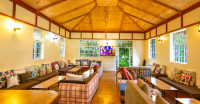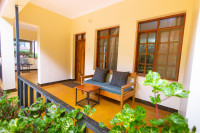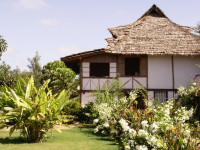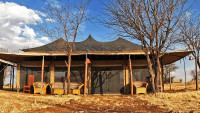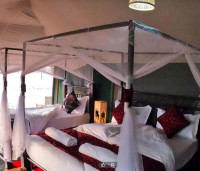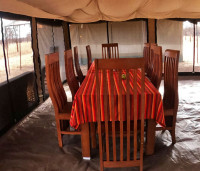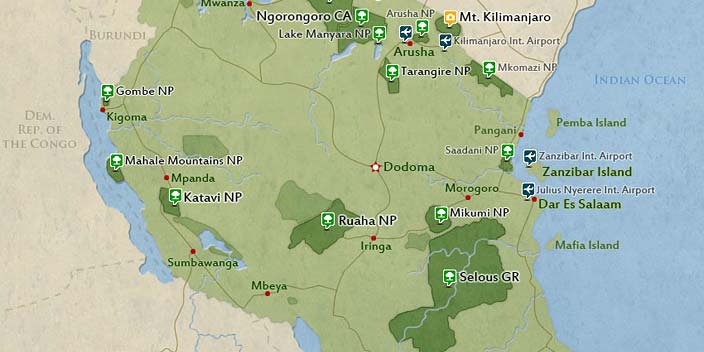
$2,212 pp (USD)
2 travelers on Start dateArrival
Arrival

Day 1
Arrival Kilimanjaro International Airport transfer to Arusha City
Arrival Kilimanjaro International Airport transfer to Arusha City
Your journey begins with your arrival at Kilimanjaro International Airport, where you will be warmly welcomed by your private driver-guide. Enjoy a scenic 1.5-hour drive to Arusha, Tanzania’s safari capital, nestled at the foot of Mount Meru.
Arusha lies in a fertile highland region, with rich volcanic soils supporting gardens of banana, coffee, and lush ornamental plants. Birdwatchers may spot sunbirds, hornbills, and weaverbirds right at the lodge.
- Main Destination:
- Arusha (City)
- Accommodation:
- Tulia Boutique Hotel & Spa
- Meals & Drinks:

Day 2
Arusha to Materuni Waterfalls
Arusha to Materuni Waterfalls
After breakfast, drive to Materuni Village, located on the slopes of Mount Kilimanjaro. Begin with a moderate hike through lush rainforest to the stunning Materuni Waterfalls (approximately 90 meters high). The path winds through banana groves and coffee plantations, offering a sensory experience of rural Tanzanian life.
Later, join a local Chagga family to learn the traditional process of making Arabica coffee — from picking the beans to roasting and grinding, followed by a cup of your own freshly brewed coffee.
- Main Destination:
- Materuni Waterfalls (Highlight)
- Accommodation:
- Tulia Boutique Hotel & Spa
- Meals & Drinks:

Day 3
Arusha to Tarangire National Park
Arusha to Tarangire National Park
Depart early for Tarangire National Park, about 2.5 hours’ drive away. This park is known for its stunning landscapes dominated by giant baobab trees and the Tarangire River, which provides a lifeline for wildlife during the dry season.
Tarangire hosts the largest concentration of elephants in northern Tanzania — often seen in herds of up to 300. Other species include lions, leopards, cheetahs, zebras, giraffes, wildebeest, impalas, warthogs, and the rare fringed-eared oryx and greater kudu.
The park’s flora includes baobabs, acacia woodlands, and combretum shrubs. The riverbanks support palm groves and seasonal marshes, attracting over 550 bird species, such as yellow-collared lovebirds, vulturine guineafowl, bustards, and fish eagles.
- Main Destination:
- Tarangire National Park
- Accommodation:
- Eileen's Trees Inn
- Meals & Drinks:

Day 4
Karatu to Serengeti National Park
Karatu to Serengeti National Park
After breakfast, drive toward Serengeti National Park, entering via the Ngorongoro Conservation Area. Enjoy a picnic lunch en route and a game drive as you approach the Seronera Valley, known as the “Big Cat capital” of Tanzania.
The Central Serengeti offers the quintessential African landscape — endless golden plains dotted with acacias and rocky outcrops (kopjes). Wildlife here is abundant year-round. Expect to see lions, cheetahs, leopards, hyenas, elephants, buffaloes, hippos, and possibly black rhinos.
During certain months (April to June, and October to December), you may witness the Great Migration — thousands of wildebeests and zebras moving in search of greener pastures. Birds include secretary birds, martial eagles, ostriches, and Kori bustards.
- Main Destination:
- Serengeti National Park
- Accommodation:
- Robin Safari Camp
- Meals & Drinks:

Day 5
Full Day Game Drive in Serengeti National Park
Full Day Game Drive in Serengeti National Park
Spend a full day immersed in the magic of the Serengeti. Your route will be flexible based on animal movements, with a picnic lunch in the bush. Experience the rhythm of nature as predators and prey interact in one of the most intact ecosystems on Earth.
You may observe lion prides hunting, cheetahs sprinting across open plains, elephants with calves, and giraffes feeding on tall acacias. The Serengeti is also known for hyena clans, bat-eared foxes, topis, grants gazelles, and servals.
Vegetation Zones:
The park transitions from grassland plains to riverine forests, and seasonal swamps, supporting varied plant and animal life.
- Main Destination:
- Serengeti National Park
- Accommodation:
- Robin Safari Camp
- Meals & Drinks:

Day 6
Serengeti to Ngorongoro Crater
Serengeti to Ngorongoro Crater
After an early breakfast, descend into the Ngorongoro Crater, the world’s largest inactive volcanic caldera. The crater floor is a natural amphitheater for wildlife, offering unmatched biodiversity in a compact space. The crater contains grassland plains, Lerai forest (home to elephants and monkeys), soda lakes like Lake Magadi (where flamingos feed), and swamps that attract hippos and waterfowl. It is a natural Eden, virtually self-contained.
Within the 260 km² floor, you may spot all members of the Big Five — lion, elephant, buffalo, black rhino, and leopard — often in a single day. Other animals include zebras, wildebeests, hippos, jackals, and eland.
After your game drive and lunch near a hippo pool, ascend the crater and proceed to Karatu for your final safari night.
- Main Destination:
- Ngorongoro Crater
- Accommodation:
- Eileen's Trees Inn
- Meals & Drinks:

Day 7
Lake Manyara National Park to Arusha
Lake Manyara National Park to Arusha
After an early breakfast, check out and drive to Lake Manyara National Park, located at the base of the Great Rift Valley escarpment. Though smaller in size, this park offers incredibly diverse scenery and wildlife within a compact area — from groundwater forests to acacia woodlands, open savannahs, and the alkaline lake itself.
Enjoy a half-day game drive, with a picnic lunch inside the park. In the afternoon, begin your return journey to Arusha. Depending on your schedule, your driver-guide can arrange brief stops at local curio shops or cultural centers. You’ll be dropped off at either your accommodation in Arusha or Kilimanjaro International Airport (JRO) for your onward travel.
- Main Destination:
- Lake Manyara National Park
- Accommodation:
- No accommodation (End of tour)
- Meals & Drinks:




